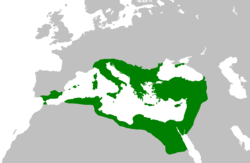ബൈസന്റൈൻ സാമ്രാജ്യം
കോൺസ്റ്റാന്റിനോപ്പിൾ തലസ്ഥാനമായി മദ്ധ്യകാലഘട്ടങ്ങളിൽ നിലനിന്നിരുന്ന കിഴക്കൻ റോമാ സാമ്രാജ്യത്തെ സൂചിപ്പിക്കാൻ ഉപയോഗിക്കുന്ന പേരുകളാണ് ബൈസന്റൈൻ സാമ്രാജ്യം[3] എന്നതും പൗരസ്ത്യ റോമാ സാമ്രാജ്യം എന്നതും. ഇവിടുത്തെ ദേശവാസികളും അയൽരാജ്യങ്ങളിൽ വസിച്ചിരുന്നവരും ഈ രാജ്യത്തെ റോമാ സാമ്രാജ്യം അഥവാ റോമാക്കാരുടെ സാമ്രാജ്യം (ഗ്രീക്കിൽ Βασιλεία των Ῥωμαίων, Basileía ton Rhōmaíōn) അല്ലെങ്കിൽ റൊമാനിയ (Ῥωμανία, Rhōmanía) എന്ന് വിളിച്ചുപോന്നു. ഇവിടുത്തെ ചക്രവർത്തിമാർ റോമാ ചക്രവർത്തിമാരുടെ പിന്തുടർച്ച തെറ്റിക്കാതെ തങ്ങളുടെ ഗ്രീക്കോ-റോമൻ നിയമ സാംസ്കാരിക പാരമ്പര്യം കാത്തുപോന്നു. ഇസ്ലാമിക ദേശങ്ങളിൽ ഇത് روم (Rûm "റോം") എന്നായിരുന്നു പ്രധാനമായും അറിയപ്പെട്ടിരുന്നത്.[4][5][6] ഇവിടെ മദ്ധ്യകാല ഗ്രീക്കുകാർ നിലനിർത്തിയിരുന്ന ഭാഷാപരവും, സാംസ്കാരികവും, ജനസംഖ്യാശാസ്ത്രപരവുമായ മുൻതൂക്കം [7] മൂലം പല പാശ്ചാത്യ യൂറോപ്പ്യൻ രാജ്യവാസികൾക്കും ഇത് ഇമ്പീരിയും ഗ്രീക്കോറും അഥവാ ഗ്രീക്കുകാരുടെ സാമ്രാജ്യം ആയിരുന്നു.
റോമാക്കാരുടെ സാമ്രാജ്യം പൗരസ്ത്യ റോമാസാമ്രാജ്യം Βασιλεία των Ῥωμαίων Basileía ton Rhōmaíōn ഇമ്പീരിയും റൊമാനോറും | |||||||||||||||||||||
|---|---|---|---|---|---|---|---|---|---|---|---|---|---|---|---|---|---|---|---|---|---|
| 330–1453 | |||||||||||||||||||||
 ഏ.ഡി. 550ൽ ജസ്റ്റീനിയന്റെ കാലത്ത് ബൈസന്റൈൻ സാമ്രാജ്യം അതിന്റെ ഏറ്റവും വലിയ വിസ്തൃതി കൈവരിച്ചപ്പോൾ. | |||||||||||||||||||||
| പദവി | സാമ്രാജ്യം | ||||||||||||||||||||
| തലസ്ഥാനം | കോൺസ്റ്റാന്റിനോപ്പിൾ¹ | ||||||||||||||||||||
| പൊതുവായ ഭാഷകൾ | ഏഴാം നൂറ്റാണ്ടുവരെ ലത്തീൻ, അതിനുശേഷം ഗ്രീക്ക് | ||||||||||||||||||||
| മതം | ക്രിസ്തുമതം : റോമാ സാമ്രാജ്യ സഭ, പൗരസ്ത്യ ഓർത്തഡോക്സ് | ||||||||||||||||||||
| ഗവൺമെൻ്റ് | രാജഭരണം | ||||||||||||||||||||
• 306–337 | ശ്രേഷ്ഠനായ കോൺസ്റ്റന്റൈൻ | ||||||||||||||||||||
• 1449–1453 | കോൺസ്റ്റന്റൈൻ XI | ||||||||||||||||||||
| നിയമനിർമ്മാണം | ബൈസന്റൈൻ സെനറ്റ് | ||||||||||||||||||||
| ചരിത്ര യുഗം | ഇരുണ്ടയുഗം മുതൽ പിൽക്കാല മദ്ധ്യയുഗം വരെ | ||||||||||||||||||||
• കോൺസ്റ്റാന്റിനോപ്പിളിന്റെ സ്ഥാപനം² | മേയ് 11 330 | ||||||||||||||||||||
• പൗരസ്ത്യ-പാശ്ചാത്യ ശീശ്മ | 1054 | ||||||||||||||||||||
• നാലാം കുരിശുയുദ്ധത്തിൽ കോൺസ്റ്റാന്റിനോപ്പിൾ കീഴടക്കുന്നു | 1204 | ||||||||||||||||||||
• കോൺസ്റ്റാന്റിനോപ്പിൾ വീണ്ടും കീഴടക്കുന്നു | 1261 | ||||||||||||||||||||
• കോൺസ്റ്റാന്റിനോപ്പിളിന്റെ പതനം | മേയ് 29 1453 | ||||||||||||||||||||
| Population | |||||||||||||||||||||
• 4ആം നൂറ്റാണ്ട്³ | 34,000,000 | ||||||||||||||||||||
• 8ആം നൂറ്റാണ്ട് (780 AD) | 7,000,000 | ||||||||||||||||||||
• 11ആം നൂറ്റാണ്ട്³ (1025 AD) | 12,000,000 | ||||||||||||||||||||
• 12ആം നൂറ്റാണ്ട്³ (1143 AD) | 10,000,000 | ||||||||||||||||||||
• 13ആം നൂറ്റാണ്ട് (1281 AD) | 5,000,000 | ||||||||||||||||||||
| നാണയവ്യവസ്ഥ | Solidus, Hyperpyron | ||||||||||||||||||||
| |||||||||||||||||||||
¹ കോൺസ്റ്റാന്റിനോപ്പിൾ (330–1204ഉം 1261–1453ഉം). The capital of the Empire of Nicaea, the empire after the Fourth Crusade, was at Nicaea, present day İznik, Turkey. ² Establishment date traditionally considered to be the re-founding of Constantinople as the capital of the Roman Empire although other dates are often used ³ See Population of the Byzantine Empire for more detailed figures taken provided by McEvedy and Jones, "Atlas of world population history", 1978, as well as Angeliki E. Laiou, "The Economic History of Byzantium", 2002. | |||||||||||||||||||||
ബൈസന്റൈൻ സാമ്രാജ്യകാലത്തെ പല ചരിത്രാവശിഷ്ടങ്ങളും തലസ്ഥാനമായിരുന്ന കോൺസ്റ്റാന്റിനോപ്പിളിൽ (ഇന്നത്തെ ഇസ്താംബൂളിൽ) ഇന്നും നിലനിൽക്കുന്നു. അയ സോഫിയ, കോറ പള്ളി എന്നിവ ഇവയിൽ ചിലതാണ്.
അവലംബം
തിരുത്തുക- ↑ Corvisier, Andre (1994). A Dictionary of Military History and the Art of War. Blackwell Publishing.
- ↑ Neubecker, Ottfried (1977). Le grand livre de l’héraldique. Elsevier Séquoïa: Brussels.
- ↑ A historiographical term used since at least the 17th century
- ↑ Seljuk, Encyclopedia of the Middle East
- Rum is the Arab word for "Rome," meaning the Byzantine empire.
- ↑ Theodoor, Martijn: E.J. Brill's First Encyclopaedia of Islam, 1913-1936, pg. 717, Brill, 1993, ISBN 978-90-04-09796-4
- Bilad al-Rum, land of the Romans
- ↑ Tarasov, Oleg: Icon and Devotion, pg. 121, Reaktion Books, 2004, ISBN 978-1-86189-118-1
- ... the 'Roman' sultanate derived its name from the Arabized form of the root of the word Roma, as did the name of individual Byzantine Greeks (Rum = Roman).
- ↑ Davies (1996), 245
* Moravcsik (1970), 11–12
* Lapidge (1998), 79
* Winnifrith–Murray (1983), 113

